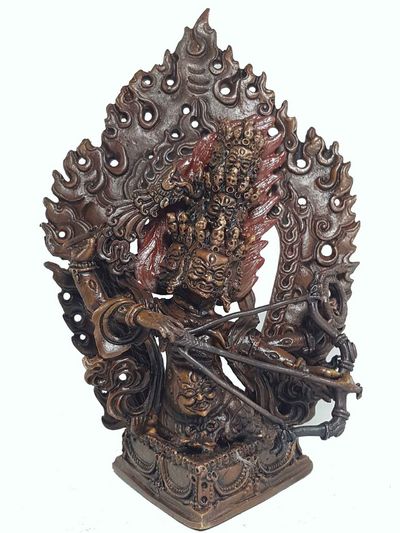Loading Content..

Rahula has arisen out of the fire of infinite ferocity. Having tricked his way to drinking the nectar of immortality he is tasked to use his venom & guile to good ends. Rahula is the great planetary deity and protector of the Dharma [set a thief to catch a thief]. The Dharma represents all the principles of Buddhism which guides sentient beings to nirvana.â He has ultimate influence over all the planets.
Rahula is represented as a Naga king with a human torso and water serpent [Skt. Naga] lower body. Nagas are primordial mythical creatures similar to snakes in appearance but with more rounded worm-like heads connected with water. Snakes such as the Cobra have a strong connection with Shiva & are more commonly distributed in Hindu art. Nagas are often shown being consumed by their mortal enemies the Garudas. In Buddhist legend the Naga King colied around Mounted Meru & pulled to & fro by the Gods & Demi-gods to up the great ocean of existence. The face in his belly is Rahulaâs actual face with large gaping central mouth which emits an effluvium of illness to protect the Buddhist teachings against enemies. He has four arms, a torso covered with one thousand eyes & nine heads representing the nine planets that Rahula has eclipsed [swallowed]. On top of these is the head of a raven symbolising Rahula who was originally a raven. When Vishnu realised that Rahula was disguised as a God & had stolen the nectar of immortality he cut Rahulaâs head off which reverted to a ravenâs. His flaming hair is driven upwards by the intensity of his tantric energy.
His top right hand brandishes a Makara Banner [Skt. Makaradhwoja] made from the flayed skin & head of a Makara. In Buddhism, a dhwoja symbolises a victory or supremacy of some kind. A Makara is a water dragon formed by the combination of several animals including the trunk of an elephant, scales of a fish, a crocodileâs mouth, the tusks of a boar and the tail feathers of a peacock. The Makhara Banner symbolises Buddhas victory over the four Maras & his immolation of the Five Afflicting Poisons. His lower right hand draws a Naga Bow [Skt. Nagadanusa] ready to shoot an arrow [Skt. Bana] into the heart of anyone who threatens the Buddhist teachings. The bow & arrow combination also represent the important âwisdom and methodâ teaching which should be used in tandem to ascend to the state of Great Bliss . The human skin is draped over his back represents his destruction of delusion, held to be the chief negative affliction. Ignorance is very much a part of the idea of delusion.
His top right hand is in threatening tarjani hand position & holds a coiled viridian serpent noose which represents the âbinding of ignoranceâ & its inherent poison. Nagas are guardians of the underworld and Buddhist teachings who control the element water & can hold back rain & cause droughts. They can be wrathful too sending disease through the rivers and streams is they are not respected. This is also a warning against ignorance and her ability obscure the truth of the Dharma and salvation from the Wheel of Cyclical Existence.
The Buddhas met on Mount Meru to discuss how to obtain the elixir of life called Dutsi as an antidote to Hala, the source of human illness that the demons have in their possession. They churned the ocean of existence to procure the Dutsi which they put into a vessel & entrusted this to the protector Vajrapani. Rahu manages to steal it, drink this elixir & then urinate into the original vessel had been put into by the Buddhas. Vajrapani realizes what has happened and sets out to kill Rahu. He asks the Sun and Moooon eventually reveals where Rahu is hiding. When slain by Vajrapani he comes back to life because he had drunk the Dutsi or, in Sanskrit, Amrita. Medicinal plants sprung up where the drops of Rahulaâs blood dripped onto the earth.
In ancient Indian text, Rahu [Rahula] was a titan who disguised himself to steal the nectar of immortality from the gods. The sun and the moon both exposed him to Vishnu who promptly cut off his head. It is believed that Rahu avenges himself by periodically swallowing up the sun and the moon, thus causing eclipses. He is hence known as the Lord of Eclipses. There are both solar eclipses involving the sun & more common lunar eclipses involving the moon. Rahulaâs myriad eyes are often compared to the starry night sky. The gaping mouth in his belly symbolizes his swallowing of the sun and the moon.
Loading..
Please wait for the page to fully load for optimal functionality.
Loading Content..